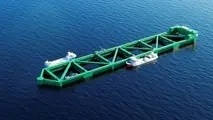Rolls-Royce Shuts Down Electrical Propulsion Business
The move ends 10 months of uncertainty after CEO Tufan Erginbilgic announced a sweeping, company-wide restructuring plan in November 2023. The new strategy signaled the sale of non-core assets, including electric propulsion, as part of a wider plan to refocus the company on its traditional turbofan business sectors.

Rolls-Royce has elected to shut down its electrical propulsion unit, Rolls-Royce Electrical, having failed to find a buyer for the business.
The move ends 10 months of uncertainty after CEO Tufan Erginbilgic announced a sweeping, company-wide restructuring plan in November 2023. The new strategy signaled the sale of non-core assets, including electric propulsion, as part of a wider plan to refocus the company on its traditional turbofan business sectors.
Having announced its intent to exit the electric power business to “focus on core growth areas,” the company was rumored to be in talks with a potential buyer last December. However, Rolls-Royce confirms to Aviation Week that it has “now moved that process to the next step.” No further details of the closure plan have been announced, though industry sources say the company will complete work under contractual obligations.
Rolls-Royce began its involvement in electric propulsion when an initial unit was set up in 2018 as part of an internal innovation hub. The initiative significantly expanded the following year by acquiring key technologies and facilities from Siemens in Germany and Hungary. In 2022 Rolls-Royce Electrical was spun out as an individual business to support both wider electrification in aerospace and the advanced air mobility market.
The company focused on the development of transverse flux, air-cooled electric propulsion units covering the 150-200 kW range for urban air mobility vehicles, as well as a larger 300-400 kW motor for regional platforms and a turbogenerator. The smaller motor initially was in development for UK-based launch customer and VX4 electric vertical-takeoff-and-landing vehicle developer Vertical Aerospace, but this program was terminated under mutual agreement in May.
Bench tests of the first 320-kW electric motor demonstrator for potential regional aircraft applications also were underway earlier this year at Rolls-Royce’s Trondheim facility in Norway following the completion of an initial passive test run in March.
Motor development had continued despite Italy-based Tecnam Aircraft’s decision in mid-2023 to suspend development of the P-Volt all-electric version of the company’s P2012 twin-engine light regional aircraft, which would have used twin 320-kW motors in place of the aircraft’s standard Lycoming piston engines. The P-Volt, which was under study by Norwegian regional airline Widerøe, was abandoned after Tecnam concluded that near-term battery technology was not sufficiently mature.
Development of the turbogenerator—targeting a 600 kW to 1.2-megawatt range—has been undertaken at the company’s Dahlewitz facility in Germany while work covering energy storage has been focused in Warwick, England.



